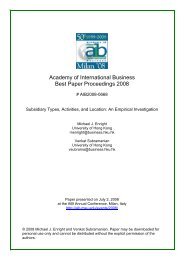AIB 2012 Conference Proceedings - Academy of International ...
AIB 2012 Conference Proceedings - Academy of International ...
AIB 2012 Conference Proceedings - Academy of International ...
Create successful ePaper yourself
Turn your PDF publications into a flip-book with our unique Google optimized e-Paper software.
TUESDAY<br />
education is and how to take more personal responsibility for their own pr<strong>of</strong>essional development. (For more<br />
information, please contact: Anne Marie Zwerg-Villegas, Universidad EAFIT, Colombia: azwerg@eafit.edu.co)<br />
Building Bridges to "Knowhere": Arts-based Pedagogy in Management Education<br />
David Trott, I-Shou University<br />
In a Taiwan-based international business administration program, students from Haiti, Holland, Hong Kong,<br />
India, Indonesia, Malaysia, Mongolia, Taiwan, Thailand, Turkmenistan, USA, and Vietnam created original<br />
artwork as metaphors for business management concepts. Students were able to widen their capacity to make<br />
sense, deepen their knowledge <strong>of</strong> core course content and engage in extemporaneous English speaking through<br />
their interpretation <strong>of</strong> original creations <strong>of</strong> 3D art work or 2D black-and-white photos. A comparison group <strong>of</strong><br />
19 USA non-traditional students also participated in the study. In total, responses by 105 students to a 22-item<br />
survey indicated that learning outcomes were met in a fulsome, creative, innovative and meaningful fashion<br />
with a level <strong>of</strong> engagement perceived as substantially deeper than traditional methods/assessments. Art-asmetaphor<br />
provides an enriching complementary approach to ways <strong>of</strong> knowing, making sense, and <strong>of</strong>fers an<br />
innovative way to facilitate verbal expression in a foreign language. This paper reviews the results <strong>of</strong> a twoyear<br />
study and further contributes to a growing rationale to include arts-based pedagogy in management<br />
education as a proven classroom teaching methodology (For more information, please contact: David Trott, I-<br />
Shou University, Taiwan: davidt@isu.edu.tw)<br />
The Aracruz Simulation: Developing Stakeholder Dialogue Skills for an Emerging Economy Context<br />
Joyce Osland, San Jose State University<br />
Asbjorn Osland, San Jose State University<br />
Carol Reade, San Jose State University<br />
Emerging economies present increasing opportunity for business expansion. <strong>International</strong> business (IB)<br />
students therefore need to become better aware <strong>of</strong> the socio-political challenges that may arise in emerging<br />
economy contexts such as poverty and civil unrest, and to gain capacity for fruitfully engaging in dialogue with<br />
diverse stakeholder groups. The Aracruz Simulation is an experiential learning exercise that can be used in the<br />
IB classroom. It is based on an actual case <strong>of</strong> the Brazilian pulp company, Aracruz Celulose, and involves a land<br />
rights controversy with indigenous and landless people, the community, a government agency that advocates<br />
for indigenous people, and NGOs protesting against the company. This pedagogical tool helps students to<br />
develop stakeholder dialogue skills that are critical for global managers and leaders. (For more information,<br />
please contact: Carol Reade, San Jose State University, USA: carol.reade@sjsu.edu)<br />
IT meet "IB": The Why and How <strong>of</strong> Injecting Culture into "IT" courses<br />
Mikelle A. Calhoun, Georgia Southern University<br />
Akhadian S. Harnowo, Georgia Southern University<br />
Toward the end <strong>of</strong> the twentieth century, technological innovations fueled globalization, reshaped business<br />
practices and focused pedagogical and empirical attention on information technology ("IT"), and the emergent<br />
topic <strong>of</strong> global supply chain management ("GSCM"). While at first limited to one firm in one country, IT<br />
facilitated international expansion. IT systems soon spanned borders and not long thereafter, through<br />
incorporation in GSCM systems, spanned different firms from different host countries. The cultural contexts <strong>of</strong><br />
IT systems increased in complexity. IT systems could be developed in one country for use by one or more firms<br />
operating across a network <strong>of</strong> different countries. As academic work caught up to international firms' IT use,<br />
studies revealed that culture influenced a range <strong>of</strong> IT concerns – from development to outcome.<br />
Notwithstanding a growing literature highlighting the significance <strong>of</strong> culture and cultural differences for<br />
understanding IT issues, review <strong>of</strong> IT curricula evidences a lack <strong>of</strong> attention to culture, cultural literacy and<br />
related social issues. The purpose <strong>of</strong> this paper is to present the argument for expanding IB into IT programs <strong>of</strong><br />
<strong>AIB</strong> <strong>2012</strong> <strong>Conference</strong> <strong>Proceedings</strong><br />
Page 214

















